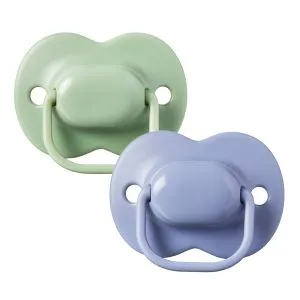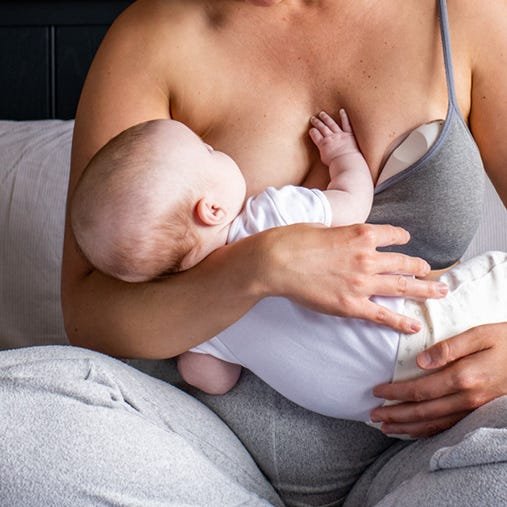If you're breastfeeding and are experiencing painful nipples, it can feel like you're all alone. But don't worry, lots of parents go through nipple soreness at some point in their breastfeeding journey.
Although breastfeeding shouldn't be painful, we know that cracked, bleeding or itchy nipples do happen, and they can be uncomfortable and upsetting.
So, we've gathered some tips and advice to help ease your discomfort and make your breastfeeding journey a little smoother. Read on to learn more about the causes and treatment for sore nipples when breastfeeding.
What causes sore nipples from breastfeeding?
Lots of parents who breastfeed will experience nipple pain at some point. Many find that their nipples are particularly sensitive in the first few days after birth and this usually improves as they continue to feed.
An incorrect latch or attachment of the baby on the breast is the most common cause of nipple pain from breastfeeding. If your baby isn't in the correct feeding position, your nipple can be squashed or rubbed by their tongue or the roof of their mouth, and this can cause pain and discomfort. If this happens, you may notice that your nipples look flattened, squashed, or red and swollen after a feed.
If you naturally have flat or inverted nipples or are breastfeeding a baby with a tongue tie, you may experience more issues with getting a proper latch.
Other reasons for breastfeeding nipple pain
The following point can also contribute to nipple or breast pain during breastfeeding:
- Skin conditions: Dermatitis around the nipple and nipple eczema can lead to pain and irritation. If you have a dry skin condition like eczema, you should ask a dermatologist or health professional's advice about medication that's safe to take when you're breastfeeding. Avoid soaps, perfumes, or detergents that can cause skin irritation because these can sometimes worsen sore nipples if they're already cracked.
- Friction from clothes: Wearing the wrong bra can add extra pressure on your nipples and make them painful.
- Nipple trauma: If your baby is removed from the breast before the suction of their latch is broken, this can be painful and potentially cause breast tissue damage. Using a breast pump incorrectly can also cause nipple soreness. So, it's important to always follow the manufacturer's instructions, and stop pumping right away if you feel uncomfortable.
- Nipple blanching (vasospasm): This term describes when the nipple is whitened and misshapen due to compression when baby is feeding. This can also lead to pain in the nipple - and is usually due to incorrect attachment.
- Milk bleb (blister): These present as white spots on the nipple and usually feel sore during a feed. They're likely caused when a duct that carries breast milk becomes inflamed and closed.
- Blocked milk ducts: Similar to milk blebs, blocked milk ducts happen when a segment of the breast becomes obstructed. This restricts the flow of breast milk and causes a tender spot or a small, sore lump.
- Mastitis: This is an inflammation of the breast. It can be due to bacterial inflammation or clogged milk ducts. It can also result in fever-like symptoms.
- Fungal infection (thrush): This can occur in the first few weeks after birth. It can cause severe, burning pain in the nipple that lasts for the whole feed, even if the baby is latched on correctly. It can also be spread as an oral infection to the baby.
- Bacterial infection: This can be mistakenly diagnosed as thrush or may present alongside thrush. It requires a medical diagnosis and treatment, so don't hesitate to speak to your doctor if you suspect that you have a bacterial infection.
Treatment options for sore nipple relief
Finding the right type of relief for your sore nipples depends on what's triggering the discomfort in the first place.
Here are some ways to alleviate nipple soreness and discomfort caused by breastfeeding:
- Ensuring your baby is properly latched onwhen feeding. Once baby's latch is improved, your sore nipples should heal on their own.
- Making sure you break the suction of their latch before removing your baby from the breast.
- Trying different breastfeeding positions to see if they work better and are more comfortable for you and baby.
- Changing your breast padsafter each feed.
- Wearing soft, cotton nursing bras that fit correctly.
- Avoiding irritants in soap or detergents. Instead, use ordinary mild soap - not antibacterial.
- Dabbing expressed breastmilk onto your nipples after feeds.
- Applying a warm compress to soothe your nipples.
- Applying a cold compress or chilled cabbage leaves can soothe sore breasts.
- Using silicone nipple shields when breastfeeding to protect your nipples.
- Applying nipple creamor purified lanolin ointment (with guidance from a GP, midwife, or lactation expert) to your nipples to soothe the pain.
- Taking breastfeeding-friendly painkillers or anti-inflammatory medication. Ibuprofen and paracetamol are compatible with breastfeeding. But if you're not sure about a painkiller, consult a pharmacist for reassurance.
- Monitoring your breasts after feeds to spot signs of issues, like mastitis.
Should I reduce or stop breastfeeding if I have sore nipples?
If you can, it's best to persevere and try to continue breastfeeding regularly to maintain your milk supply. Expressing your breast milk manually or using a breast pump and then feeding your baby with a bottle can help by giving your nipples a break and time to heal.
Even in the case of a breast infection like mastitis, it's best to continue breastfeeding if you can, unless you've been advised otherwise by a health professional. The antibodies in your milk help to protect your baby from infections.
What if nipple pain after breastfeeding doesn't get better?
If you're experiencing pain when feeding or sore nipples that are not healing, you should ask for help and advice from your health visitor, doctor, or the Australian Lactation Consultants Directory.










